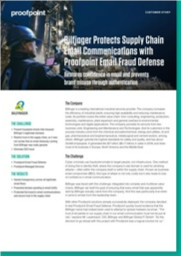Bilfinger Protects Supply Chain Email Communications
Restores confidence in email and prevents brand misuse through authentication.
Cyber criminals use fraudulent emails to target people, not infrastructure. One method of doing this is identity theft, where the company's real domain is used for phishing attacks—often within the company itself or within the supply chain. Known as business email compromise (BEC), this type of attack is not only costly but it also leads to loss of confidence in email communication.
Bilfinger was faced with this challenge. Integrated into complex and multilevel value chains, Bilfinger set itself the goal of ensuring that every email that was apparently sent by Bilfinger actually came from the company. And this was particularly true when it came to emails from the leadership team.
With other Proofpoint solutions already successfully deployed, the company decided to test Proofpoint Email Fraud Defense. Download now to read Proofpoint's findings.
Read More
By submitting this form you agree to Proofpoint contacting you with marketing-related emails or by telephone. You may unsubscribe at any time. Proofpoint web sites and communications are subject to their Privacy Notice.
By requesting this resource you agree to our terms of use. All data is protected by our Privacy Notice. If you have any further questions please email dataprotection@techpublishhub.com
Related Categories: Applications, Cloud, Compliance, Email, Malware, NAS, Service Providers


More resources from Proofpoint

Research Report: ESG Analyses the Economic Be...
Did you know the average annual cost for insider threats is now $11.45M, according to Ponemon Institute? It's a growing problem as remote teams bec...

Protecting The End User
A people-centric approach to managing vulnerability, attacks and privilege. Organisations are spending more than ever on cybersecurity and getting ...

The Hidden Costs of Free: Are Microsoft 365â€...
All email, cloud, and compliance solutions are not created equal. As organisations make the move to Microsoft 365, many assume that the platform's ...